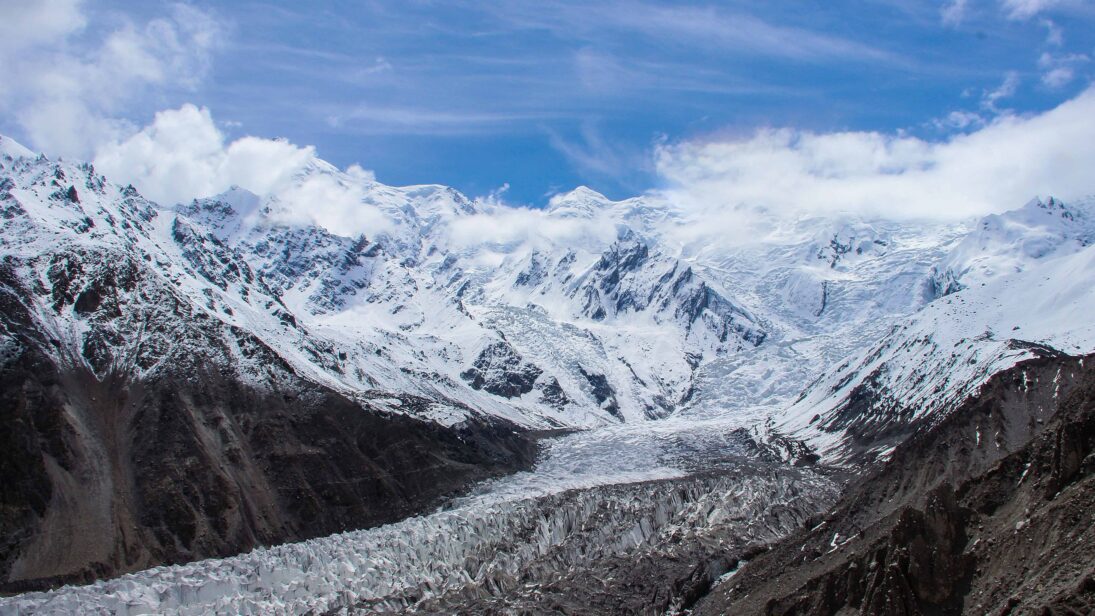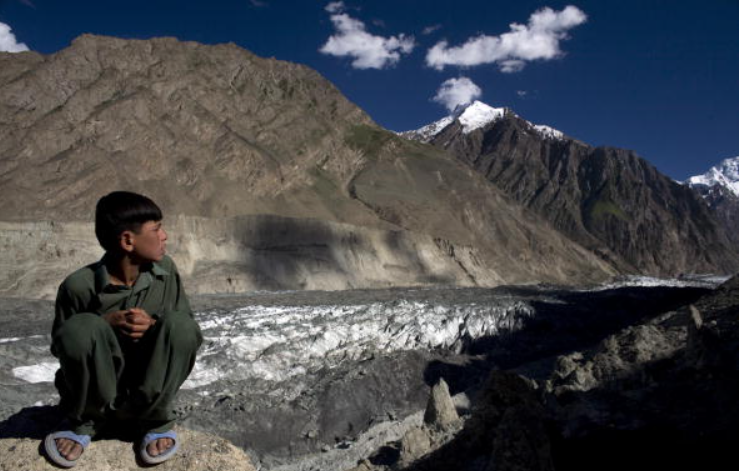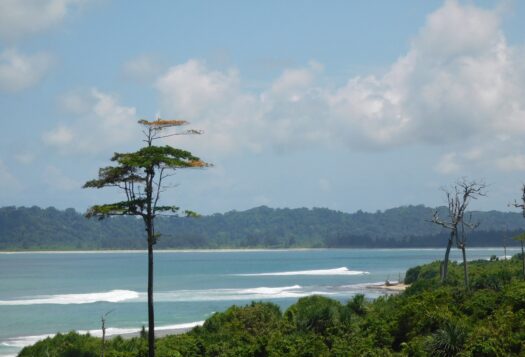
The contested highlands of the Himalaya-Karakoram-Hindukush (HKH) mountain ranges—spanning across South Asia through Ladakh, Aksai Chin, Jammu and Kashmir, and Gilgit-Baltistan—remain highly vulnerable to climate change and kinetic conflict. These highlands are the globe’s third pole, harboring more ice in their glaciers than anywhere outside Antarctica and the Arctic.1 Almost two billion people across Pakistan, India, Afghanistan, and China are directly or indirectly dependent on freshwater from the highlands, making it impossible to underestimate the importance of the Himalaya-Karakoram-Hindukush mountain ranges for South Asia.
Mountain ranges, river basins, and climate change do not respect international borders. However, defying geography, nation-states use territorial sovereignty to claim natural resources within their borders. This leads to the potential for interstate conflict over natural resources as global warming, climate catastrophes, and glacier melt simultaneously make these regions and South Asia vulnerable to floods and droughts in the short and medium run, and dry rivers in the long run.2
Simultaneously, previously relatively dormant territorial disputes between India and Pakistan, as well as China and India, have become more active since New Delhi’s unilateral act of scrapping Kashmir’s autonomous status on August 5, 2019. Renewed claims between India and Pakistan over the entirety of Jammu and Kashmir, Ladakh, and Gilgit-Baltistan—as well as India and China contesting border claims in Aksai Chin and Ladakh—have increased the region’s political salience. As geopolitical tensions compound with climate change and resource scarcity, the Himalaya-Karakoram-Hindukush highlands could trigger an existential crisis for the region in years to come.
The disputed nature of the Himalaya-Karakoram-Hindukush highlands, and harsh living conditions for mountain communities, have left the region under-developed compared to the mainland areas in Pakistan, China, and India. The most immediate and pragmatic step to meet the challenge of climate change in South Asia is to show political will to develop a collective consensus to improve the mountain communities’ environmental resilience and mitigate potential downstream conflicts through conflict resolution.
Geopolitical uncertainty and regional escalation have increased the demand for out-of-the-box initiatives to resolve disputes, especially for regions that are vital sources of fresh water. The contested claims and disputes over regions in the Himalaya-Karakoram-Hindukush mountain range between adversarial states not only continue to be potential flashpoints for conflict—while also directly threatening mega glaciers—but remain the main hurdle for undertaking joint climate action.
Pakistan-administered Gilgit-Baltistan possesses the largest concentration of glaciers and demands unequivocal attention for joint climate action in South Asia.
Among these regions across Himalaya-Karakoram-Hindukush, Pakistan-administered Gilgit-Baltistan possesses the largest concentration of glaciers and demands unequivocal attention for joint climate action in South Asia. Moreover, the region’s unique geographical position at the junction of Pakistan, China, India and Afghanistan, and great potential to generate harmony and economic activity—through trade, transit, tourism and energy generation—offer opportunities to spur regional dispute resolution mechanisms and undertake concerted joint-climate action.
Global Warming’s Existential Threat to South Asia
Out of the last twenty-two years, twenty years have been the hottest in recorded history. Experts have suggested measures to restrict the global temperature rise to 1.5 degrees Celsius, and cautioned that even a two-degree Celsius increase in average temperatures would have devastating effects on life on earth. However, if current trends hold, the United Nations estimates that the average global temperature will rise from three degrees Celsius to five degrees Celsius until the end of this century. In the Himalaya-Karakoram-Hindukush highlands, these changed environmental conditions will affect billions of people through impacts on irrigation, agriculture, tourism, hydroelectric power, access to drinking water, flooding, and potential cross-border conflict.
Should current trends hold, until 2060, the annual river flows in South Asia will continue rising due to rapid glacier melt because of global warming, followed by a sharp decline due to depleted glacier mass.3 According to glacial assessments in the Himalaya-Karakoram-Hindukush highlands, even if the global temperatures are restricted to a 1.5 degrees Celsius rise, 36 percent of the glaciers will disappear by 2100.4 An increase of two degrees Celsius will extinguish half of the glaciers, while a four-to-five-degree-Celsius rise will cause two-thirds of the glaciers to melt.5 About 15 percent of these glaciers have already melted since the 1970s.
South Asia’s Climate Security and U.S. Strategic Concerns
From “threat multiplier” to a “potential threat,” the impacts of climate change—especially in disproportionately affected regions such as South Asia—are changing perceptions in local and international strategic communities.6 While initial U.S. studies showed water scarcity as a threat capable of causing intrastate conflicts along ethnic lines, more recent reports showed concerns about states using transboundary river basins as “leverage over their neighbors to preserve their water interests.” The National Intelligence Estimate has cautioned about “medium risk” of cross-border water tensions and conflicts through 2030, while “high risk” is predicted through to 2040. Pakistan, India, and Afghanistan have been identified as highly vulnerable countries of concern.
2021 remained significant in setting milestones for climate action through COP 26. Almost all major powers, including the United States, China, and the European Union, pledged to contribute and achieve carbon neutrality in a specific course of time. Pakistan and India, too, have set their own targets: while India works to be carbon neutral by 2070, Pakistan has pledged 50 percent carbon neutrality by 2030. It appears that the United States and regional powers have realized and identified common areas to tackle, while also sharing responsibilities, primarily through green financing schemes. However, there is a dire need to prioritize these efforts. Rising sea levels, climate refugees, and water wars are expected to put additional demands on U.S. diplomatic, economic, humanitarian, and military leadership.
There is a dire need to prioritize climate preservation efforts as rising sea levels, climate refugees, and water wars are expected to put additional demands on U.S. diplomatic, economic, humanitarian, and military leadership.
The preservation of mega glacier bodies and sustainability of the highlands is crucial to contain floods, sea rise, climate migrants, and direct confrontations over water. United States President Joe Biden has launched PREPARE, an emergency plan to support environmental resilience for developing countries and vulnerable communities, to adapt to—and effectively manage—the impacts of climate change. This would expedite states’ Nationally Determined Contributions and help undertake joint initiatives to uplift dilapidated mountain communities. However, special efforts are required to pacify disputes over these highlands to undertake a concerted action against climate and reaching a permanent and long-term solution.
The Case for Gilgit-Baltistan
While a climate-induced war over shared river basins is anticipated in the medium to long run, the threat of a potential conflict due to the contested claims over these mountain communities between adversarial states in South Asia seems imminent. Moreover, the Indus Water Treaty (1960) not only reduces the possibilities of a regional water war between India and Pakistan but also sets precedent for broader regional climate agreements. A direct clash due to overlapping water claims between India and Pakistan, and India and China, over the Himalaya-Karakoram-Hindukush region risks the degradation of the environment, especially through damage to mega glaciers. That, coupled with climate-induced continuous depletion of mountain ice and water shortages, might force upper riparian states to either change the course of river flow—through barrages, reservoirs, and dams—to meet the growing demand of their populations. China holds the most advantageous position when it comes to riparian states.
While this makes dispute mitigation and resolution a prerequisite to overcome anticipated water wars and undertake joint-climate action, the prevailing geopolitical situation over these mountain communities has been grim, especially after India’s annexation of Kashmir’s autonomous status on August 5, 2019. New Delhi’s unilateral actions allowed both Pakistan and China to react. While Islamabad mulls introducing legislation to induct Gilgit-Baltistan as a fifth province, Beijing has been fortifying its defenses along the Aksai Chin and Ladakh border.

Gilgit-Baltistan stretches along almost 73,000 square kilometers at the junction of Hindukush, Karakoram, and Himalayas, sharing a border with China, India, and Afghanistan, with historic links to Central, South, and Southeast Asian peripheries. China’s ongoing geo-economic initiatives in South Asia have improved infrastructure, communication, and the prospects of Gilgit-Baltistan becoming a vibrant trade and transit hub. Additionally, Gilgit-Baltistan—with thousands of megawatts of potential capacity to generate run-of-the-river, environmentally friendly hydroelectric power plants—can not only uplift its own energy generation, but export surplus capacity to other nearby grids and provinces. Moreover, existing avenues of tourism and adventure sports, if enhanced with developing and promoting eco-friendly models and better infrastructure, can open vistas of cooperation by improving people-to-people relations. Above all, like people across Himalaya-Karakoram-Hindukush mountain communities, the resilient yet under-represented masses of Gilgit-Baltistan are skilled in every manner to take the lead to undertake these various initiatives.
Gilgit-Baltistan—with thousands of megawatts of potential capacity to generate run-of-the-river, environmentally friendly hydroelectric power plants—can not only uplift its own energy generation, but export surplus capacity to other nearby grids and provinces.
Pakistani and Chinese cooperation and infrastructure development in Gilgit-Baltistan—seen most vociferously through the construction of the Karakoram Highway, one of the highest-altitude highways in the world, and several mega infrastructure projects under the China Pakistan Economic Corridor (CPEC) over the past decade—have been crucial to connect this otherwise inaccessible region. The formal provision of provincial status would open vistas of cooperation for more actors. India’s opposition to prevailing geo-economic trends in Gilgit-Baltistan—under the premise that the region is part of India’s new “union territory of Ladakh”—complicates the prospects of joint-climate action in South Asia, while also increasing the chances of a conflict. In the past, New Delhi’s objections stopped international organizations from funding developmental projects in Gilgit-Baltistan.
Due to a lack of broader regional and international cooperation, largely inaccessible terrain, and harsh living conditions, Gilgit-Baltistan remains in a state of distress. Access to basic human needs like clean drinking water, electricity, and housing remains a daily challenge. The haphazard urban development in cities like Gilgit and Skardu, without proper sewerage and drainage systems, has been adding to the climate hazards by causing water pollution and erosion. More alarmingly, during harsh winter months, the region faces on average 48 hours of consecutive power cuts, forcing people to cut trees to fulfill their needs. This leads to unregulated deforestation, soil erosion, and air pollution, which, while necessary for local populations to survive harsh winters, also increases the chances of climate hazards like landslides, floods, and forest fires.
Access to basic human needs like clean drinking water, electricity, and housing remains a daily challenge in Gilgit-Baltistan.
While Gilgit-Baltistan’s vital freshwater sources have been losing mass due to global warming, the largest among them, the Siachen glacier, is actively being contested by India and Pakistan. The Indian force deployment during operation Meghdoot in 1984 had led Pakistan to send its forces to the glacier, making it the world’s highest battlefield. Beforehand, as a result of the border agreement of 1963 with Pakistan, China held control of the strategically located Trans-Karakoram Tract, which is to the northwest of the disputed Siachen glacier. The charged regional security situation, overt militarization of parts of the Himalaya-Karakoram-Hindukush region, and globally rising temperatures have added to both the impacts of environmental degradation and chances of a direct confrontation.
Amid the prevailing dual crises, Gilgit-Baltistan presents an opportunity for regional and global cooperation for joint-climate action. However, that partially seems to be contingent on how India configures its policies towards the region. A cooperative approach would not only help undertake a holistic action towards the region’s problems but also improve New Delhi’s chances to access Central Asia through Gilgit-Baltistan.
Policy Recommendations
Reorienting U.S. Policy Approaches in the Himalaya-Karakoram-Hindukush through Joint Climate Action
The United States’ engagement with the Himalaya-Karakoram-Hindukush highlands has historically hinged on regional geopolitics and bilateral relationships. However, recognizing that South Asia will experience disproportionate effects of climate change in years to come, the United States is concerned about the downstream effects of climate change and future conflict in South Asia. A more concerted policy focus on contested regional claims and their downstream climate consequences could encourage regional and international joint climate action in the Himalaya-Karakoram-Hindukush region.
Establish a Center for Climate Action and Resilience in Gilgit-Baltistan
In the Himalaya-Karakoram-Hindukush regions, indigenous mountain communities offer an alternative for effective climate action. With local adaptation and resilience techniques cultivated over several centuries, indigenous mountain communities possess knowledge bases largely overlooked in state capitals. Academicians, scientists, and technocrats should work in tandem with local populations on the feasibility and effectiveness of top-down climate action. A new regional office devoted exclusively to improving mountain-specific climate resilience could improve center-state-province communication and implementation. Representatives of this office should not only engage with central governments but also the international community through United Nations agencies to share best practices for climate resilience in mountainous regions.
Leverage International Climate Green Financing Schemes
South Asian states should leverage global international climate financing options such as PREPARE to improve climate resilience and adaptation. South Asian policymakers should work towards reducing red tape and bureaucratic impediments that could jeopardize or delay international climate financing. Buy-in from indigenous mountain communities is essential for internationally funded top-down projects to sustain themselves. It is important that the international community and state bodies ensure that new projects sufficiently address local demands and are consistent with the Himalaya-Karakoram-Hindukush’s distinct contextual requirements.
Revitalize SAARC through Joint Climate Action in South Asia
Tensions between India and Pakistan have limited SAARC’s ability to realize its mandate of fostering regional cooperation. However, the COVID-19 pandemic brought all countries together to share their experiences and establish a mutual assistance fund. Similarly, SAARC can pivot future engagements through joint climate action in South Asia and the Himalaya-Karakoram-Hindukush region. Given the relatively depoliticized nature of climate impact in South Asia, the new pivot on joint climate actions offers hope for sustained engagement. Once SAARC is revived for climate action, South Asian countries can work towards a broader water treaty that also includes China.
Working towards More Concrete Confidence-Building Measures (CBM)
CBMs relating to demilitarizing the Himalaya-Karakoram-Hindukush highlands, such as creating a “Siachen Science Park,’ are not new.7 However, growing regional escalation and global warming have accentuated the need for undertaking such initiatives with greater intensity. CBMs geared towards prohibiting the use of nuclear weapons over the Himalaya-Karakoram-Hindukush highlands, while also advancing cooperation for the peaceful usage of nuclear technology across the Himalaya-Karakoram-Hindukush region, could begin a wider process to de-securitize a heavily securitized region.
Declare the Himalaya-Karakoram-Hindukush region a Global Environmental Free Zone
Ultimately, declaring the Himalaya-Karakoram-Hindukush region a Global Environmental Free Zone may seem idealistic because it would entail visa, trade, and barrier-free connectivity in a region dominated by adversaries. However, such a move would create a cooperative environment for regional engagement, increase collective revenue generation, and improve the lived experience for impoverished families and wildlife living across borders. Working on means and mechanisms to meet this end requires significant and coordinated efforts from local, regional and international actors. However, doing so can be the most significant step to not only untap the region’s socio-economic and uphold environmental protection but also reach a permanent and long-term solution for durable peace and security in all its forms.
Editor’s Note: This piece is part of a collection of policy memos published by South Asian Voices Visiting Fellows and was originally published on the Stimson Center website in May 2022. The Visiting Fellowship is a year long fellowship that combines professional development of research, writing, and public speaking skills with extensive exposure to the D.C. policy community. More information on the South Asian Voices Visiting Fellowship is available here.
***
Image 1: via Wikimedia Commons
Image 2: Paula Bronstein via Getty Images
- Sharma E. et al., “Introduction to the Hindu Kush Himalaya Assessment” in Wester P., Mishra A., Mukherji A., Shrestha A. (eds) The Hindu Kush Himalaya Assessment (Switzerland: SpringerLink, 2019).
- Bolch T. et al., “Status and Change of the Cryosphere in the Extended Hindu Kush Himalaya Region,” in Wester P., Mishra A., Mukherji A., Shrestha A. (eds) The Hindu Kush Himalaya Assessment (Switzerland: SpringerLink, 2019).
- Bolch T. et al., “Status and Change of the Cryosphere in the Extended Hindu Kush Himalaya Region” in Wester P., Mishra A., Mukherji A., Shrestha A. (eds) The Hindu Kush Himalaya Assessment (Switzerland: Springer Link, 2019).
- Ibid.
- Ibid.
- CNA Corporation, “National Security and the Threat of Climate Change,” (Alexandria, VA: CNA, 2007), 6.
- Neal A. Kemkar, “Environmental Peacekeeping: Ending Conflict between India and Pakistan on the Siachen Glacier Through the Creation of a Transboundary Peace Park,” Stanford Environmental Law Journal 25 (Winter 2005), 3.


